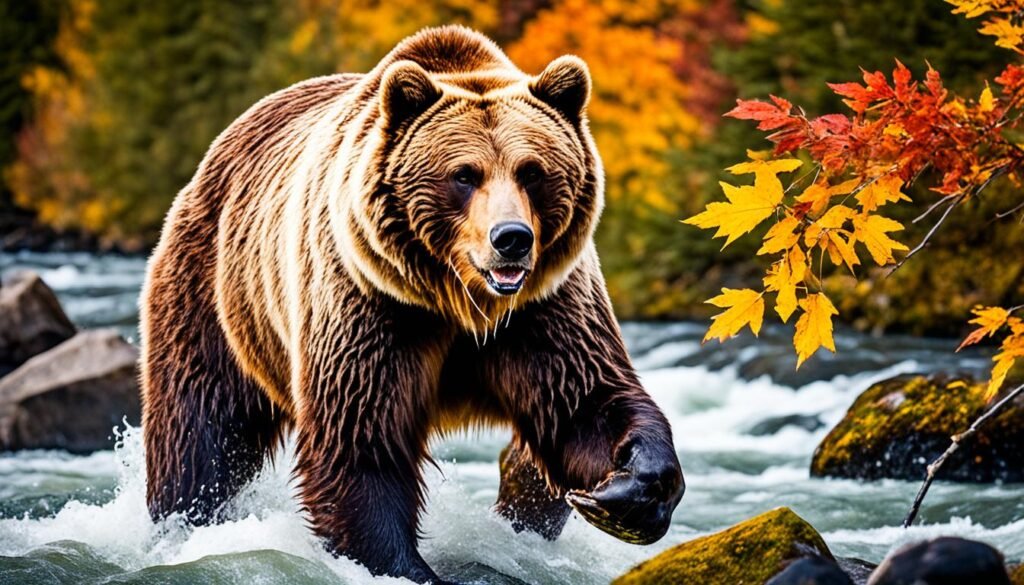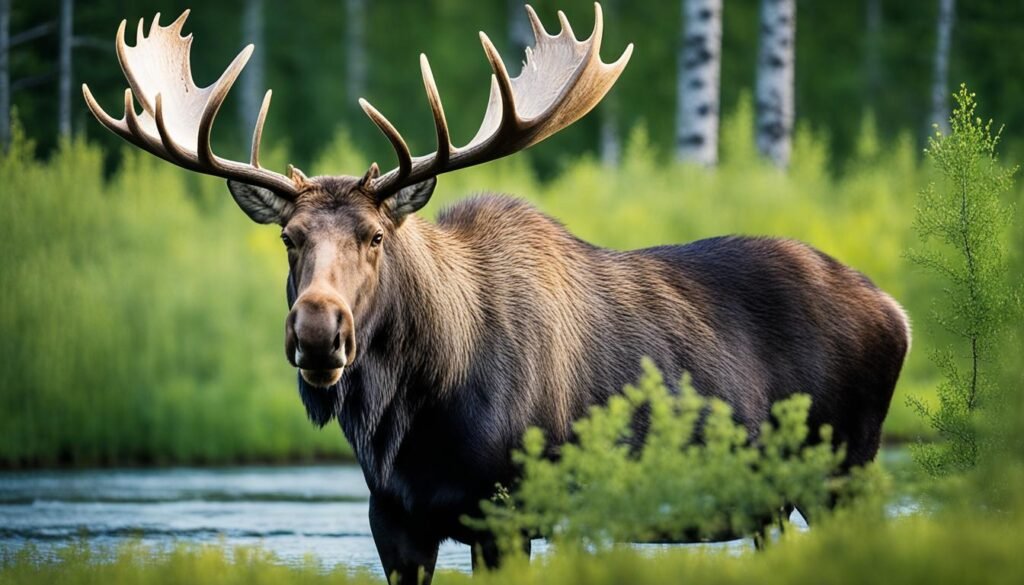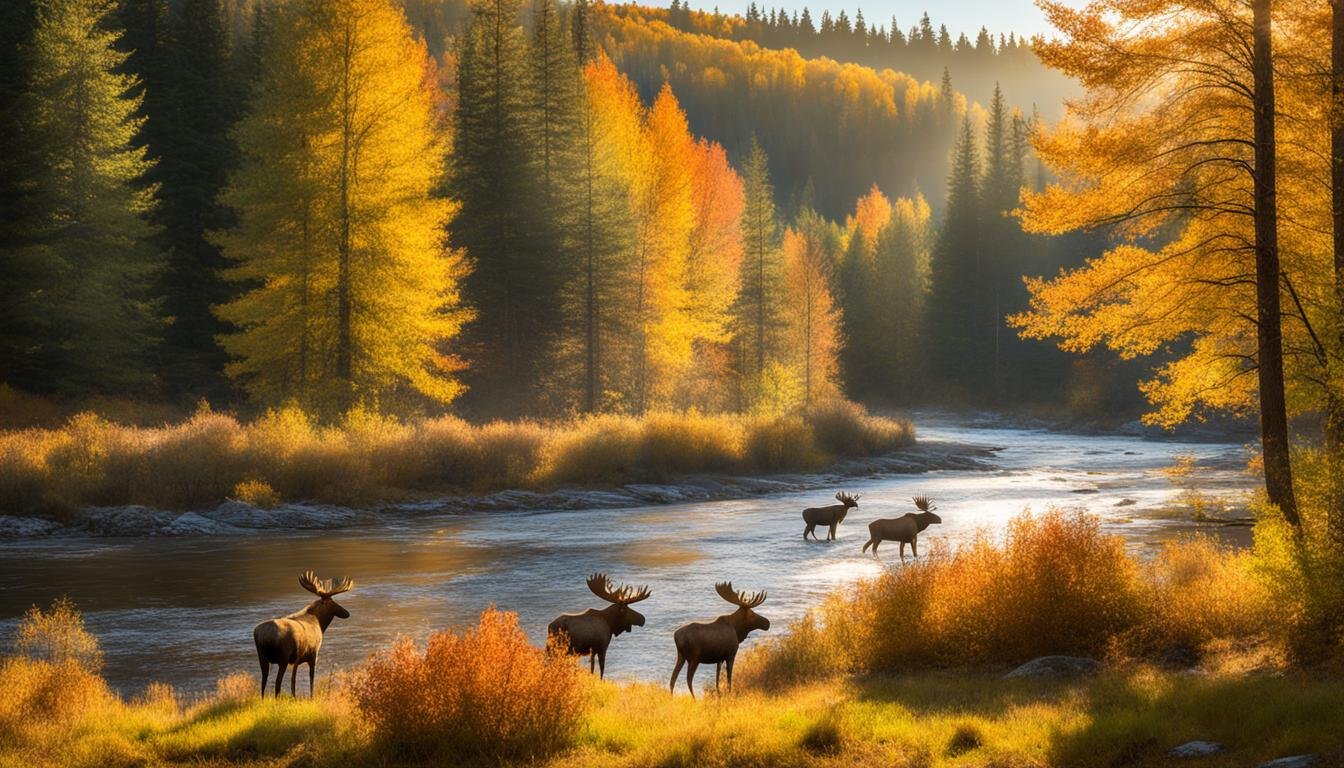Ever wondered when is the best time to see wildlife in Canada’s vast lands?
Canada is a top spot for seasonal wildlife watching, thanks to its varied landscapes. From the Rocky Mountains to the Arctic tundra, it’s a place where nature’s beauty is on full display.
Canada has over 50 National Wildlife Areas (NWAs) managed by Environment and Climate Change Canada. These areas are perfect for wildlife watching.
Places like the Alaksen National Wildlife Area see up to 1.4 million migratory birds every year. Others, like Vaseux-Bighorn National Wildlife Area, are home to endangered California Bighorn Sheep.
If you want to see a Grizzly bear in summer or Snowy Owls in winter, knowing when to go is key. The best times for wildlife watching are during certain seasons.
This article will guide you on when and where to see nature’s amazing animals.
Key Takeaways about Seasonal Wildlife Viewing
- Canada features over 50 National Wildlife Areas managed for wildlife conservation.
- Spring and early summer are ideal for witnessing migratory behaviours and newborn wildlife.
- Winter is perfect for observing species like Bald Eagles and Snowy Owls.
- Fall showcases vibrant foliage and migratory routes for diverse bird species.
- Understanding seasonal animal behaviour enhances your viewing experience.
Introduction to Canada’s Wildlife Viewing Opportunities
Canada’s stunning landscapes and rich wildlife make it a top spot for wildlife watching. With vast national parks like Banff and Churchill, the country offers amazing wildlife viewing experiences in Canada.
These places are full of species that live in their natural settings, showing why we must protect them.
Statistics show that 91 percent of Canadians, about 19 million people, enjoy wildlife in their free time. A big 86 percent see the need for lots of wildlife, and 83 percent know we must protect endangered species.
Wildlife adds beauty to Canada and supports life on Earth, so it’s key for nature lovers to watch responsibly.
Many visitors come to see wildlife up close. For example, around 3.9 million Canadians go on trips to see wildlife in the wild. Doing wildlife-related activities helps local economies, like the $6 million spent by bird watchers at Point Pelee National Park.
As more people learn about wildlife conservation, there’s more demand for guided tours and learning programs. Places like Knight Inlet Lodge and Sidney Whale Watching offer deep experiences.
They let visitors connect with nature without disturbing it. Knowing the best times and places to see wildlife makes these experiences even better, letting visitors see amazing moments up close.
| Statistic | Percentage/Number |
|---|---|
| Canadians involved in wildlife activities | 91% (19 million) |
| Canadians prioritizing abundant wildlife | 86% |
| Canadians protecting endangered species | 83% |
| Individuals participating in wildlife-related activities | 70% (14.5 million) |
| Canadians who feed wildlife | 6.6 million |
| Those on wildlife-focused trips | 3.9 million |
| Individuals who hunt | 1.5 million |
| People participating in recreational fishing | 5.5 million |
| Canadians involved in wildlife organizations | 1.9 million |
| Engagement with wildlife-related media | 85% (17.7 million) |
The Importance of Seasonal Wildlife Viewing

Seasonal wildlife viewing is key to connecting us with nature. It shows us the complex world of animals. Animals change their behavior with the seasons, like migrating or breeding. Learning about these changes makes wildlife watching more meaningful.
Seeing moose in spring or polar bears in autumn shows the beauty of Canada’s nature. It highlights the diversity of animal behavior.
Understanding Animal Behavior
Wildlife acts differently with the seasons. In spring, animals wake up and look for food or care for their young. Fall brings mating and getting ready for winter.
This knowledge makes wildlife tourism better. It helps people connect with nature’s cycles.
Benefits of Wildlife Viewing for Ecotourism
Wildlife watching is more than fun. It helps local communities by bringing in tourists. These visitors support small businesses and conservation efforts.
This tourism also makes people care more about nature. It helps protect habitats and fights environmental issues. Watching wildlife responsibly is good for nature and local economies.
| Season | Wildlife Species | Key Behaviours | Ecotourism Impact |
|---|---|---|---|
| Spring | Moose, Bears | Breeding, Foraging | Increased visitor numbers |
| Summer | Birds, Grizzly Bears | Feeding, Offspring Care | Boost local economies |
| Autumn | Elk, Bighorn Sheep | Mating, Preparing for Winter | Heightened awareness on conservation |
| Winter | Wolves, Snowy Owls | Hunting, Migration | Encourages habitat protection |
Wildlife Viewing in Winter: December to February
Winter turns Canada into a stunning wilderness full of chances to see winter species. You can spot majestic bald eagles and elusive snowy owls against the snowy backdrop.
With fewer leaves on trees, it’s easier to see wildlife, making the season even more beautiful.
Species to Observe: Bald Eagles and Snowy Owls
The bald eagle and snowy owl are top winter species to see. They live in places like British Columbia and Ontario, where the coast and lakes are great for watching.
Bald eagles are easy to spot because of their big wingspan. Snowy owls look almost invisible in the snow, but you can see them hunting and behaving in the winter.
Best Locations for Winter Wildlife Watching
Canada has many great spots for seeing winter wildlife.
Some top places include:
- Great Bear Rainforest, British Columbia: This area is perfect for bald eagles and snowy owls.
- Algonquin Provincial Park, Ontario: It has ski trails and shelters for easy access to see moose and white-tailed deer.
- Lamar Valley, Yellowstone National Park: In winter, you can see bison, coyotes, and elk here.
These spots let you see birds and mammals that live in the cold. Seeing how they adapt to winter is amazing and makes you appreciate nature more.
When watching wildlife, use a tracking guide to identify animal tracks. Always keep a safe distance to respect their space.
This way, you can enjoy nature without disturbing it. For outdoor fun beyond winter, check out this guide to the best times for fishing in Canada.
Spring Awakening: March to May

Spring brings life back to Canada’s wilderness. It’s a time of renewal for plants and animals. The spring migration of many animals starts, filling the air with sounds.
Birds sing, and moose come out with their babies. Seeing these animals in nature is a special experience for anyone who loves nature.
Migration Patterns of Birds and Other Animals
March to May is a busy time for wildlife. Many birds, like warblers and raptors, head north.
In April and May, birds return from their winter homes, finding better living conditions.
- Blackcap, chiffchaff, wheatear, and sand martin are among the first to arrive.
- Local birds like blackbirds, blue tits, and great tits start nesting in late February.
- Humpback Whales migrate too, with 85% going to Hawaii to breed, while others go to Mexico.
Perfect Timing for Moose Sightings in Parks
Spring is the best time to see moose. Places like Algonquin Park are great for spotting these big animals. Moose moms come out with their calves, offering great photo ops. Early morning or evening are the best times to see them.
| Wildlife Activity | Best Months | Common Species |
|---|---|---|
| Bird Migration | March – May | Warblers, Raptors, Blackcap, Wheatear |
| Moose Sightings | April – May | Moose with calves |
| Transient Killer Whales | March – April | Killer Whales |
Spring is a great time to explore Canada’s nature. It’s perfect for spring wildlife viewing. Nature lovers and photographers will find it unforgettable.
Summer Adventures: June to August
Summer is the best time to see wildlife in Canada. Nature lovers flock to the beautiful landscapes to see many species. The warm weather makes animals more active, perfect for outdoor fun in national parks.
This season is great for seeing wildlife like grizzly bears and bighorn sheep. They are amazing to watch.
Peak Wildlife Viewing Season in Canada
Summer brings exciting chances to see wildlife. The long days make the landscapes look stunning and are great for watching animals.
Grizzly bears are often seen in alpine meadows, showing off their size and beauty.
Canada’s national parks are full of different animals to see in the summer. Each place has its own unique wildlife.
Popular Species: Grizzly Bears and Bighorn Sheep
In the Canadian Rockies, grizzly bears and bighorn sheep are favorites among visitors. Grizzly bears are often seen during the day in places like Banff National Park. They look for food.
Bighorn sheep can be seen on mountain trails. They are very agile as they move over rocky areas. Seeing these animals is great for photography and making memories.
| Species | Best Viewing Locations | Typical Behaviour |
|---|---|---|
| Grizzly Bear | Banff National Park | Foraging in meadows, often seen in early morning or late afternoon |
| Bighorn Sheep | Jasper National Park | Climbing steep slopes, often observed in groups |
| Waterfowl | Maligne Lake | Nesting and feeding in lakes and wetlands |
Experience the magic of Canada’s wildlife in summer. Enjoy the stunning views and maybe see amazing animals. Whether you’re hiking, canoeing, or just enjoying nature, seeing wildlife is unforgettable. It helps us appreciate Canada’s natural beauty.
Autumn Spectacle: September to November
As summer ends and autumn arrives, Canada opens up amazing chances to see wildlife. In Churchill and Banff National Park, the fall season is perfect for wildlife watching.
The autumn animal behaviour changes dramatically, offering a unique experience for enthusiasts.
Viewing Polar Bears in Churchill
Churchill is known as the polar bear capital. From October to November, these huge animals wait by Hudson Bay for the ice to form.
This is a key time for polar bear watching. Visitors can see polar bears in their natural setting, moving and interacting as they get ready for winter.
Elk Rutting Season in Banff National Park
In Banff National Park, the elk rutting season happens in September and October. This is when male elk fight for mates.
The sight of their courtship and sounds adds to the autumn wildlife experience. People come to see the elk’s energy and beauty during this important time.
| Location | Wildlife | Best Time for Viewing |
|---|---|---|
| Churchill | Polar Bears | October to November |
| Banff National Park | Elk | September to October |
Seasonal Wildlife Viewing: Best Practices for Observers
Watching wildlife is exciting and connects us with nature. But, it’s key to be safe and respectful around animals. Following good tips makes your experience safer and helps the animals too. It’s important to keep a safe distance from animals.
For big animals like bears, stay at least 100 meters away. Don’t try to corner them and change your path if they seem scared. Knowing how animals act during different seasons helps you watch them safely.
For example, spring is busy in places like Whistler as many animals come out after hibernation.
Wildlife Spotting Tips and Safety Considerations
- Learn about the local animals and how they behave.
- Use binoculars or a camera with a long lens to watch animals without bothering them.
- Don’t bring food with you, as it can draw animals to you and lead to dangerous situations.
- Follow park rules, including speed limits, to avoid hitting animals and keep the area peaceful.
- Tell the local rangers if you see any strange animal behavior or health issues to keep the area safe for everyone.
Many people love wildlife photography. Learning about nature photography can make capturing wildlife moments better.
Knowing how animals act and the best times to take photos, like at dawn or dusk, will improve your pictures.
How to Capture Seasonal Nature Photography
- Pick the right gear; a good telephoto lens lets you get close without scaring animals.
- Be patient; sometimes, waiting quietly lets animals act naturally, making for great photos.
- Use natural light; soft light in the morning or late afternoon makes animals look beautiful.
- Look at the background; it can add to your photo and make it look amazing.
- Follow the rules for taking photos, making sure you don’t scare or bother the animals.
Watching wildlife is a fun way to learn respect for nature and its creatures. By following these tips, you can enjoy seeing animals in their natural setting safely.
This helps the animals and makes your experience better. For more advice, check out this resource.
Top Wildlife Viewing Locations Across Canada
Canada is a paradise for nature lovers, with a wide range of places to see wildlife. From the stunning landscapes of British Columbia to the vast marine world of the Gulf of Saint Lawrence, each spot offers a unique chance to see wildlife up close.
British Columbia’s Great Bear Rainforest
The Great Bear Rainforest is a top spot for wildlife watching in Canada. It’s known for its rich variety of life, including black bears, grizzly bears, and many marine animals. Visitors can see both land and sea creatures, like humpback whales and orcas.
This area is important for protecting nature and offers tours that help the environment. By visiting, you help with conservation efforts and see Canada’s untouched beauty.
Viewing Opportunities at the Gulf of Saint Lawrence
The Gulf of Saint Lawrence is a top place for seeing marine wildlife. Here, you can see beluga whales, minke whales, and many seals. Boat tours take you deep into the Gulf, showing its rich marine life and supporting its protection.
This area is dedicated to saving its wildlife and homes. It’s perfect for those who love nature.
For a whale watching trip you won’t forget, Prince of Whales in Victoria, British Columbia, offers tours. They promise to show you marine wildlife and teach you about protecting the ocean.
What to Bring for Wildlife Viewing Expeditions
Getting ready for wildlife viewing can make your experience much better. It’s important to pack the right gear for your trips. You’ll need high-quality binoculars to see animals far away, field guides to identify them, and clothes that can handle different weather.
Comfortable hiking boots are a must for walking on various landscapes. Don’t forget to bring enough food and water to keep you going all day.
Essential Gear for All Seasons
There are more items you should consider to make your trip successful. A light backpack is great for carrying your stuff and keeping your hands free. If you’re going where bears or other wildlife might be, bear spray is a smart safety item to bring.
Since the Canadian outdoors can be unpredictable, wearing layers of clothing is key. This helps you stay warm and dry, no matter what the weather does.
Photography Equipment for Capturing Wildlife Moments
If you want to take photos of wildlife, you need the right gear. A strong camera with a long lens lets you get close-up shots without scaring the animals. Make sure you have extra batteries and memory cards so you won’t miss any special moments.
A tripod helps keep your camera steady, making your photos look better. Good photography gear not only keeps your memories safe but also lets you connect more deeply with Canada’s amazing wildlife.
FAQ about Seasonal Wildlife Viewing
What is the best time for seasonal wildlife viewing in Canada?
The best times for wildlife watching change with the seasons. Spring is great for seeing animals move to new places. Summer is when animals are most active. Autumn is the best time to see polar bears. Winter lets you spot bald eagles and snowy owls.
Where can I observe wildlife during different seasons?
You can see wildlife in many places. Banff National Park is good for summer bear sightings. Churchill is where you can see polar bears in autumn. The Great Bear Rainforest has many species all year.
Why is understanding seasonal animal behaviour important for wildlife viewing?
Knowing when animals move or mate helps you see them better. It makes your wildlife watching more rewarding.
What are some tips for observing wildlife safely?
Keep a safe distance from animals, at least 100 meters from bears. Don’t get too close or corner them. This keeps you safe and respects the animals.
What type of equipment should I bring for wildlife photography?
For wildlife photos, use a camera with a long lens. Don’t forget extra batteries, memory cards, and a strong tripod. These will help you take great seasonal nature photos.
Which locations are known for marine wildlife viewing?
The Gulf of Saint Lawrence is famous for its marine wildlife. You can see humpback and beluga whales, dolphins, and seals there.
How does wildlife viewing contribute to ecotourism?
Wildlife watching helps ecotourism by bringing money to local areas. It supports conservation and teaches people about the need to protect nature.
What should I wear for wildlife viewing in different seasons?
Dress right for the weather. Wear layers for cold months and good hiking boots for your outdoor adventures.
Source Links
- https://www.canada.ca/en/environment-climate-change/services/national-wildlife-areas/10-great-places-connect-with-nature.html
- https://canadiantrainvacations.com/blog/best-time-to-visit-banff
- https://www.intrepidtravel.com/au/canada/best-time-to-visit-canada
- https://www.hww.ca/en/issues-and-topics/benefits-of-wildlife.html
- https://www.indigenousbc.com/things-to-do/wildlife-and-nature
- https://www.ncbi.nlm.nih.gov/pmc/articles/PMC4764957/
- https://tetonwild.com/the-best-time-to-visit-the-teton-wildlife-tours-a-guide-to-seasonal-wildlife-viewing/
- https://mountainhouse.com/blogs/backpacking-hiking/best-winter-wildlife-viewing?srsltid=AfmBOor9EFOOB1fw6Kh-TQ0I8L6_Tw8dVziuC0PxCNuw_hF6Z-ohfxt0
- https://www.hww.ca/en/issues-and-topics/wildlife-in-winter.html
- https://www.yellowstonenationalparklodges.com/connect/yellowstone-hot-spot/secrets-of-winter-wildlife-watching/
- https://campbellriverwhalewatching.com/blog/the-seasonal-guide-to-whale-wildlife-and-bear-watching-in-campbell-river-vancouver-island/
- https://www.woodlandtrust.org.uk/blog/2021/02/first-spring-signs-in-nature/
- https://travelnunavut.ca/story/a-plan-for-all-seasons
- https://www.jasper-park-lodge.com/experience/seasonal-activity-guide/summer/
- https://epicrides.ca/whistler/whistler-seasons-guide-to-weather-activities/
- https://www.kootenayrockies.com/autumn-vibes-in-the-kootenays/
- https://epicrides.ca/blog/whistler-wildlife-sightings-a-seasonal-guide-strong/
- https://home.nps.gov/olym/planyourvisit/wildlife-viewing.htm
- https://www.travelyukon.com/en/get-inspired/spring-wildlife-migration
- https://www.destinationontario.com/en-ca/articles/top-parks-visit-ontario-canada
- https://outershores.ca/faq/
- https://home.nps.gov/grca/learn/nature/wildlife_alert.htm

